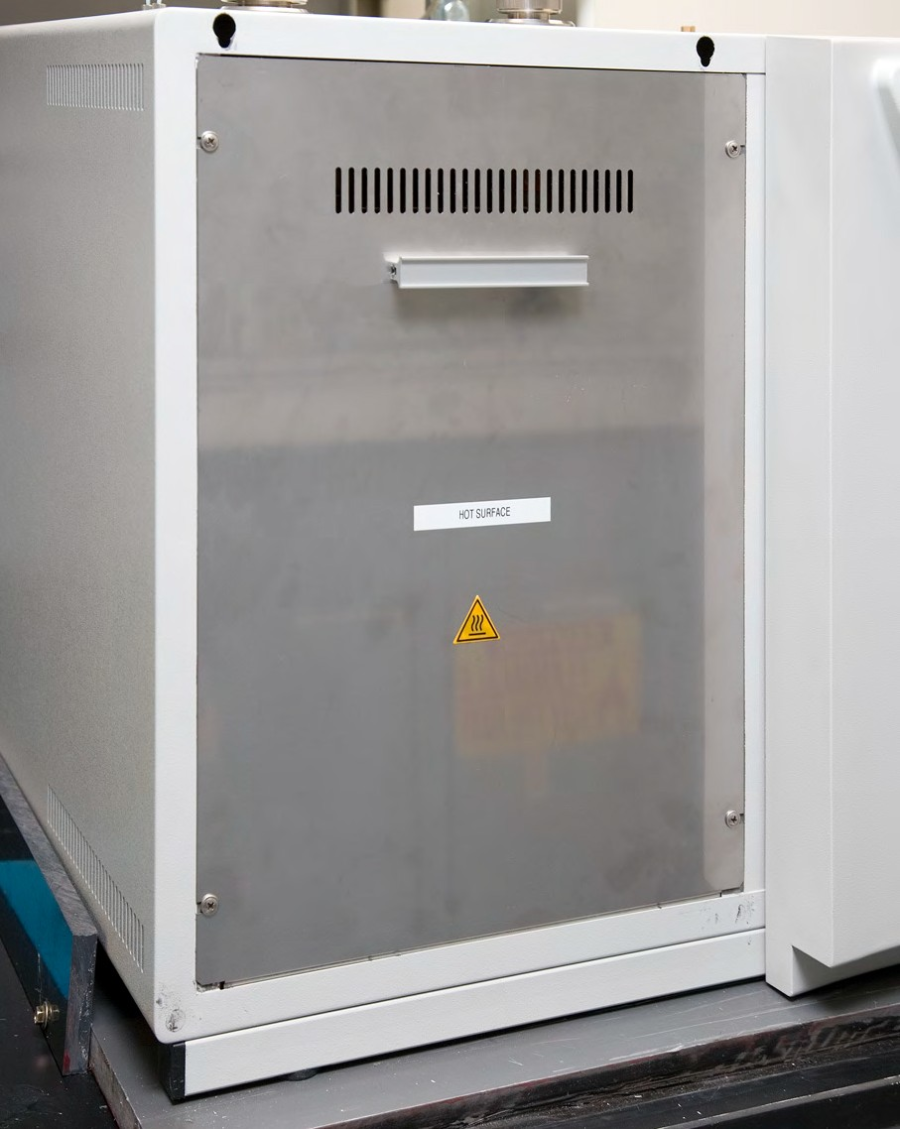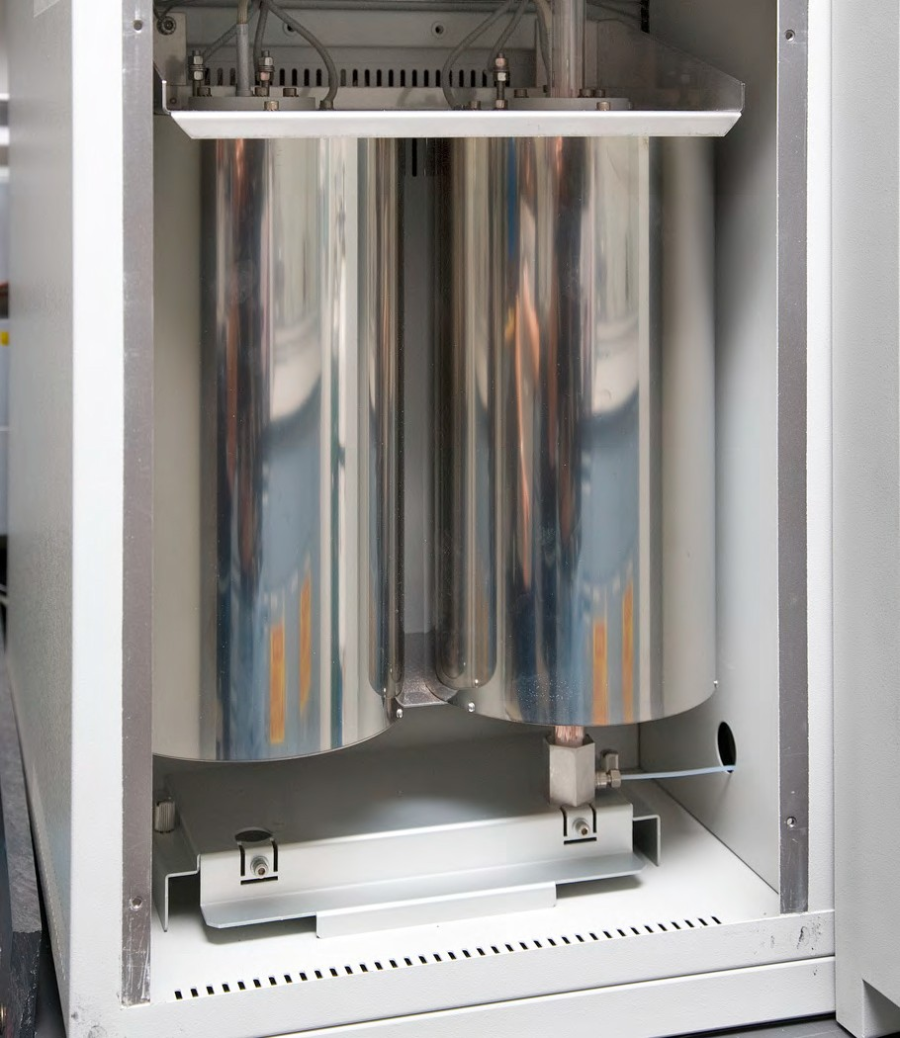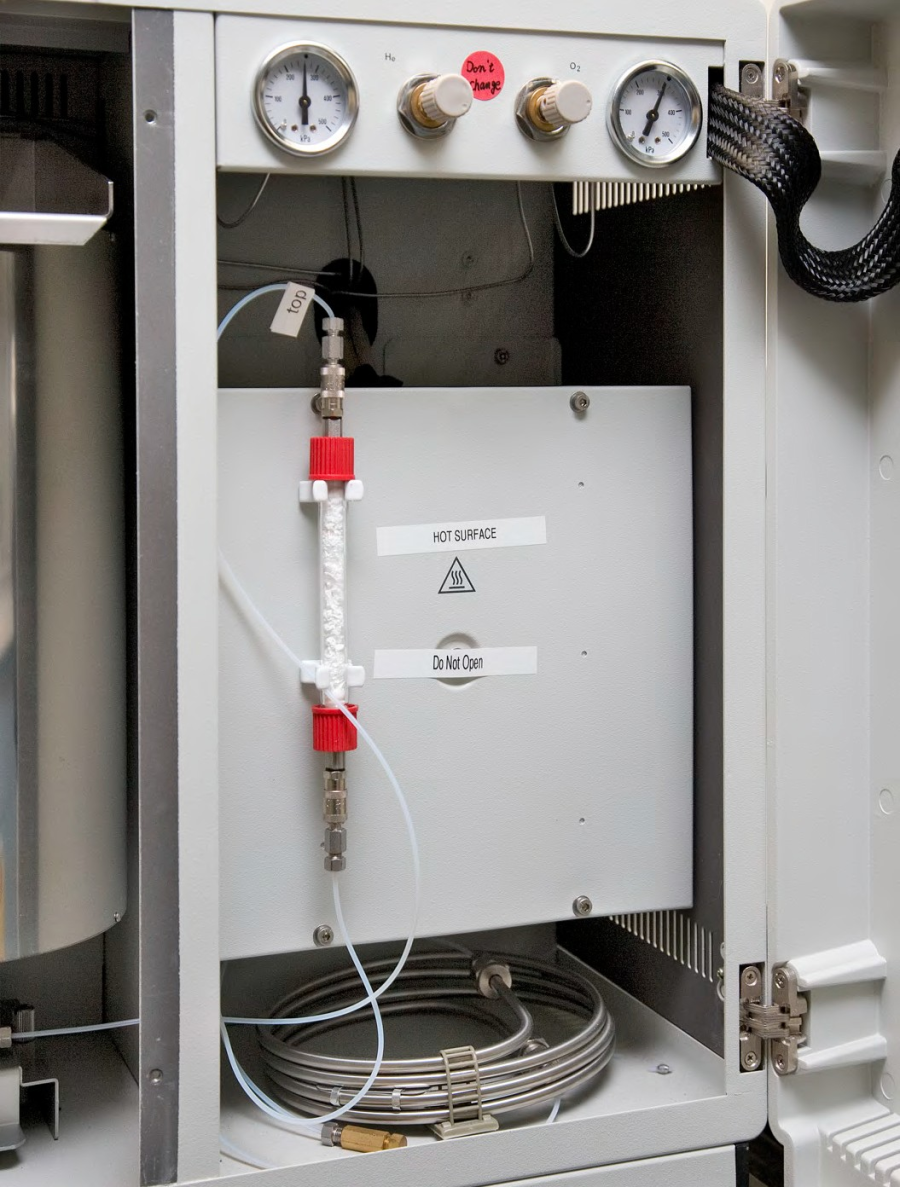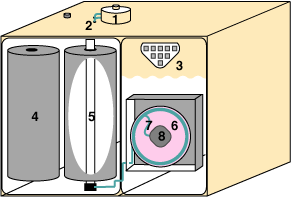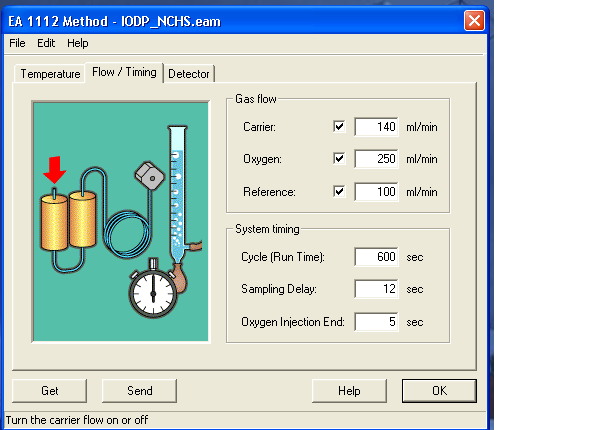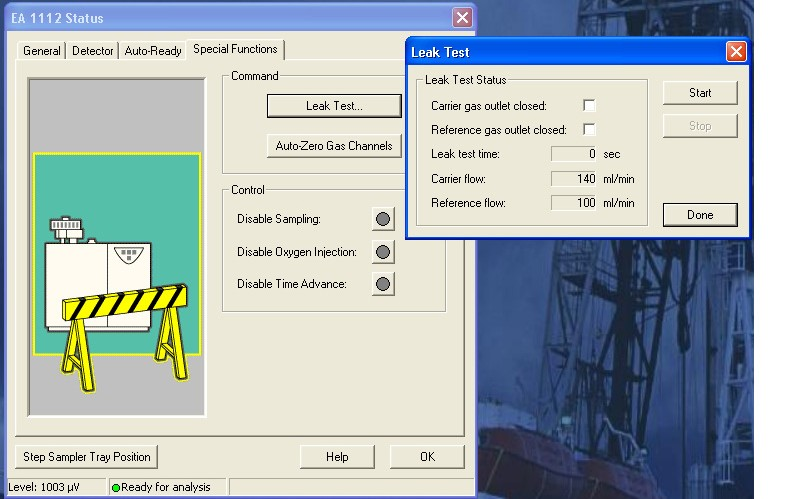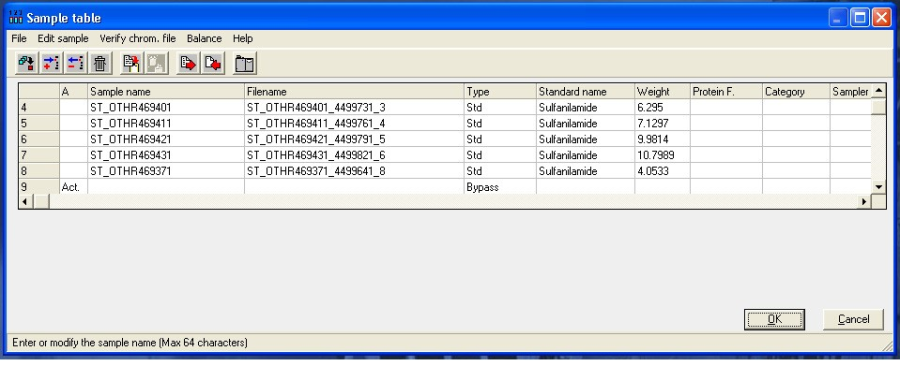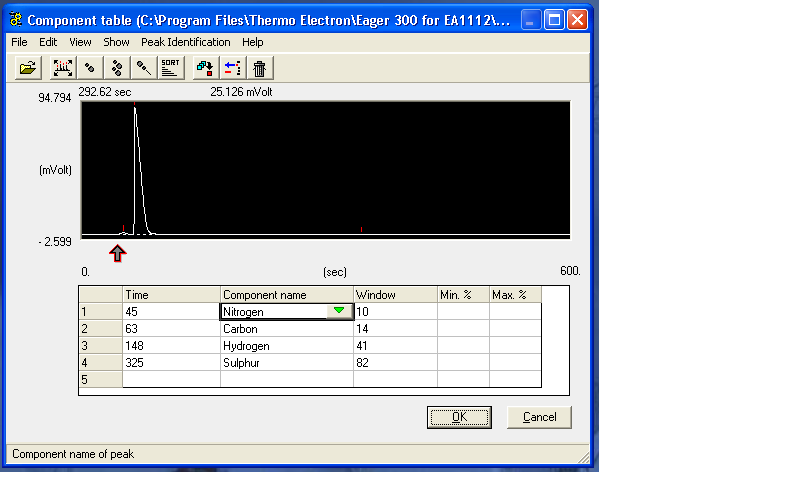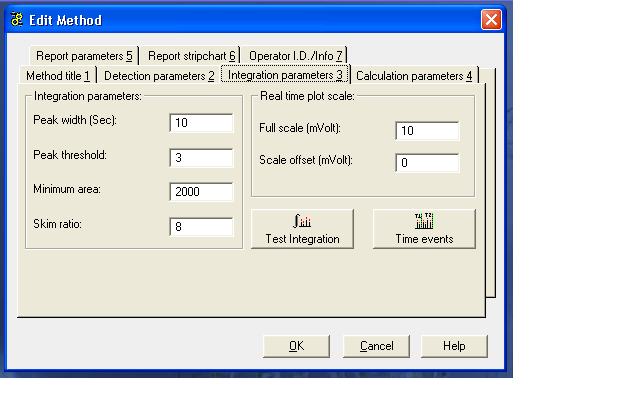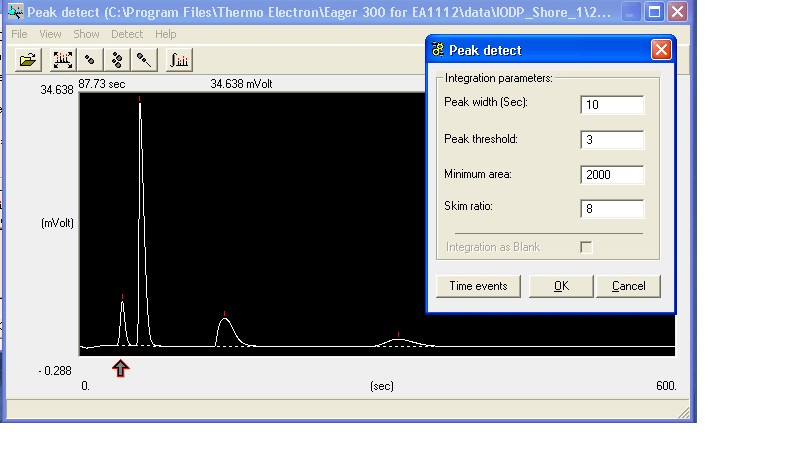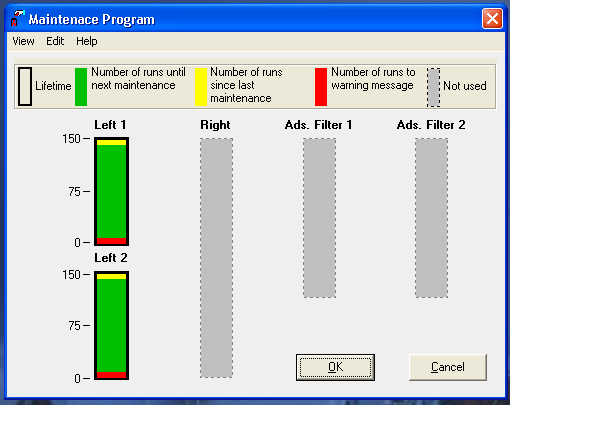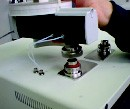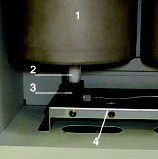Introduction
Carbon, hydrogen, nitrogen, and sulfur (CHNS) are fundamental elemental components that are analyzed on the ship during IODP expeditions. Fluctuations in the concentration and/or content ratio of carbon, nitrogen, and sulfur define the origin, depositional environment, and diagenetic alteration of source materials. A few options for sample preparation method, instrument settings, and measurement methodology exist. In addition to the pre-generated methods, specific analytical methodology may be required based on the nature of certain sample materials. In this case, new methods will be created by the laboratory technicians working in conjunction with the scientists. Each instrument method is recorded by the USIO and will be associated with the measurements performed under that method.
Carbon Analysis
Most marine sediments and sedimentary rocks contain both carbonate ("inorganic") carbon and organic carbon. The CHNS procedure measures total carbon (inorganic plus organic) when following the standard method. Organic carbon content is then determined by using the inorganic carbon value from coulometric analysis and calculating the difference between total carbon from CHNS analysis and inorganic carbon analyzed by coulometer. Alternative methodologies can be employed to measure organic and inorganic carbon.
Nitrogen Analysis
Nitrogen is one of the important limiting nutrients in the ocean. The global carbon cycle and, consequently, atmospheric CO2 might be tightly coupled to the nitrogen cycle, and therefore changes in the magnitude of the sinks and sources of fixed nitrogen in the oceans can significantly influence global climate. Biological nitrogen fixation, denitrification, and consumption of nitrate by phytoplankton are the major biological processes of the global nitrogen cycle. Changes in ocean circulation and nutrient supply, which occur in response to changes in environmental conditions, affect the relative importance and spatial extent of the major pathways of the nitrogen cycle.
Carbon-Nitrogen Relationship
C-N signatures indicate diagenesis and changes in productivity in seafloor sediments. Diagenesis may cause a decrease in C/N with decoupled C-N concentration variations, whereas productivity changes tend to produce C-N covariance in concentrations at relatively constant C/N ratios. Without significant superimposed diagenetic effects, linear relationships between C and N compositions can in some cases be interpreted as reflecting sources of organic matter:
- C/N = 6–8: fresh marine organic matter
- C/N = 8–20: degraded marine organic matter
- C/N > 20: continental organic matter
Low C/N values occur in sediment that is poor in organic carbon; these values may be biased by the tendency of clay minerals to absorb ammonium ions generated during the degradation of organic matter. Sediments rich in TOC have higher C/N values than sediments lean in TOC. C/N values that are elevated above algal values are common in organic carbon-rich marine sediments. These values evidently result from the selective loss of nitrogen as organic matter settles from the photic zone because nitrogen-bearing proteins are more labile than other organic matter components such as carbohydrates and lipids. This type of preferential nitrogen depletion and consequent carbon enrichment is recognized in organic carbon-rich sediments. C/N elevations are most pronounced when TOC concentrations are highest, suggesting that a higher rate of organic matter delivery leads to diminished organic matter degradation.
Sulfur Analysis
Cycling of sulfur compounds is a ubiquitous process in marine sediments that supports a range of microbial metabolic strategies. The occurrence of sulfur over a wide range of oxidation states (–2 to +6) allows sulfur species to serve as both electron acceptors and electron donors. In reduced form as sulfide (H2S = H2S(aq) + HS–), sulfur is also an important sink for reactive iron. The reduction of sulfate to sulfide is by far the most important pathway for sedimentary organic matter oxidation in anoxic marine sediments, and there is evidence that anaerobic oxidation of methane controls microbial sulfate reduction (MSR) in many marine systems.
Much of the sulfide produced during dissimilatory MSR in marine sediments is oxidized back to sulfate by a variety of biological and abiotic pathways, and sulfate produced by oxidation of sulfide may have variable isotope values reflecting the nature and complexity of the abiotic and biological oxidation pathways and relative contributions from different oxidants. These pathways often include the production of intermediate sulfur species such as elemental sulfur and thiosulfate, which can undergo further bacterial disproportionation reactions that may lead to further fractionations of both sulfur and oxygen isotopes in secondary sulfate.
Elemental sulfur is a possible intermediate in pyrite formation and may serve as an indicator for active SO4 reduction. Elemental sulfur enrichments may form at places where the sulfide concentrations were high, resulting from in situ SO42– reduction. Elemental sulfur forms from partial oxidation of sulfide. In addition, low-molecular-weight organic sulfur compounds are included in elemental sulfur.
Sulfur-Carbon Relationship
In normal marine sediments the relation between sulfur and carbon contents has a slope of 1/2.8 (Stot/Corg ratio, wt%/wt%) and passes through the origin (assuming that sulfur fractions other than reduced sulfur are relatively negligible). In euxinic marine environments, however, sulfide is omnipresent (independent of local Corg contents) and iron sulfide formation can take place in the water column or at the sediment/water interface.
In addition, even slowly reacting iron compounds may react with sulfide in euxinic environments. Consequently, positive intercepts on the sulfur axis are obtained in sulfur vs. carbon plots for euxinic sediments, and only weak correlations may be observed. Additionally, post-depositional sulfidization of Corg-poor sediments may result in extremely high sulfur/carbon ratios.
Theory of Operation
Dried and powdered samples are combusted in a tin sample crucible with vanadium pentoxide catalyst, purified by a reactor packed with electrolytic copper and copper oxide, separated on a gas chromatographic column, and analyzed using a thermal conductivity detector (TCD). Addition of the V2O5 ensures complete conversion of inorganic sulfur in the sample to sulfur dioxide.
When the tin crucible with sample is dropped into the reactor, the oxygen environment triggers a strong exothermic reaction. Temperature rises to 1800°C, causing the sample to combust. The combustion products are conveyed across the reactor, where oxidation is completed. Nitrogen oxides and sulfur trioxide are reduced to elemental nitrogen and sulfur dioxide, and oxygen excess is retained. The gas mixture containing N2, CO2, H2O, and SO2 flows into the chromatographic column, where separation takes place. Eluted gases are sent to the TCD where electrical signals processed by the Eager 300 software provide percentages of nitrogen, carbon, hydrogen, and sulfur contained in the sample.
Equipement and Reagents
Equipement
Carbon, hydrogen, nitrogen, and sulfur are analyzed on a Thermo Electron Corporation FlashSmart CHNS elemental analyzer (Figure 1) with autosampler (Figure 2).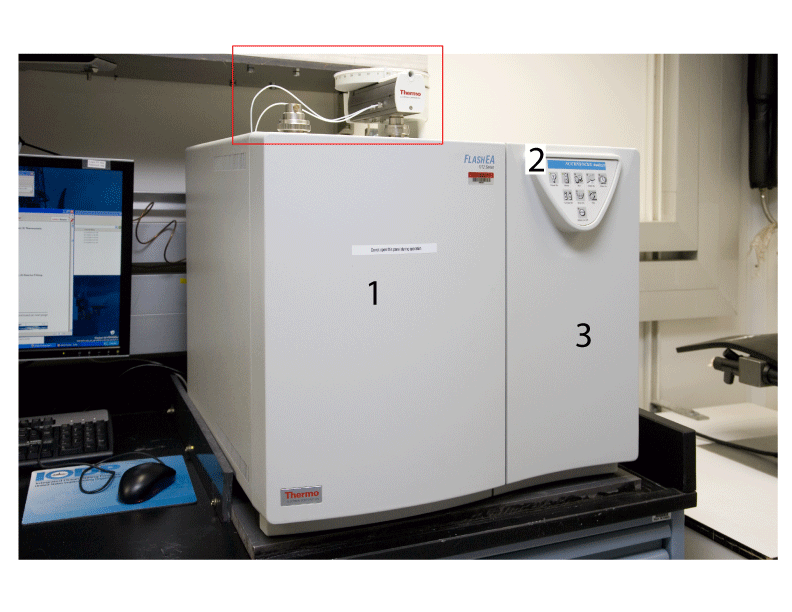
Figure 1. Elemental Analyzer: (1) Furnace Access Door, (2) Synoptic Panel, and (3) Thermostatic Chamber Access. Dry Sample Autosampler is located on top of furnace.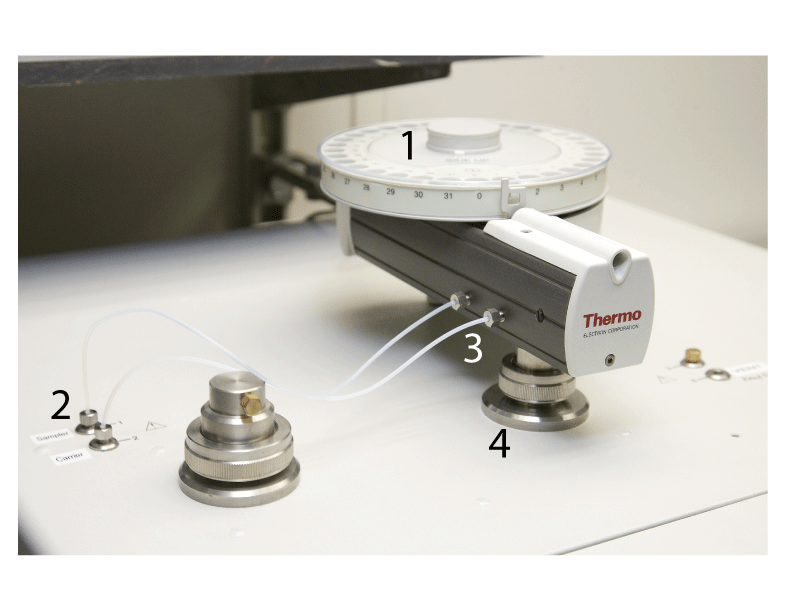
Figure 2. Dry Sample Autosampler (red box in Figure 1): (1) Drum, (2) Gas Connection Fitting, (3) Gas Tube, and (4) Reactor Fitting
Figure 4. Furnace Compartment Access with Protection Plate
WARNING! Do not open the furnace compartment during operation
Figure 5. Interior Furnace Compartment
WARNING: Do not touch either furnace when the furnace temperature is >40°C (To check temperature, select View > View Elemental Analyzer Status)
Figure 6. Detector Access: Protection Plate, GC Column (inside), Adsorption Filter
WARNING: The GC column may only be serviced by the shipboard technicians
Instrument Description
C, H, N, and S are analyzed on a Thermo Electron Corporation FlashEA 1112 CHNS elemental analyzer (Figure 1, below) with the following specifications:
–Supplier: Thermo Electron Corporation
–Model: FlashEA 1112
–Detector: Thermal conductivity detector (TCD)
–Instrument Control: Eager 300 software for MS Windows
–Power Supply: 230 V AC; 60 Hz (US); 140 VA
–Dimensions: 500 mm H × 590 mm W × 558 mm D
–Weight: 65 kg
–Measurement Range: 100 ppm to 100% for C, N, H, and S
–Nominal Measurement Time: CNS: 8 min, CHNS: 10 min
–Sample Weight: 0.01–100 mg according to nature of the sample
–Temperature range:15°–35°C Maximum rel. humidity:30%–85%
The basic CHNS instrument configuration contains the following components.
CHNS Components
1. Autosampler (highlighted in red in Figure 2 and shown in detail in Figure 3)
2. Gas tubing for helium and oxygen
3. Synoptic panel
4. Furnace (furnace cover plate shown in Figure 4; opened plate in Figure 5)
5. Reactor
6. Oven
7. Water adsorption column (shown in Figure 6)
7. Gas chromatographic column (also in Figure 6)
8. TCD detector
Reagents
Be sure to read the Health, Safety, and Environment section before using any of the chemicals and reagents in this method.
Note that many of these materials are hazardous and before any work is done with them, the user must be familiar with the appropriate Material Safety Data Sheets (MSDS).
Material Name | Description | Purpose |
|---|---|---|
Aspartic acid | C4H7NO4: white fine crystals | Standard reference material |
2.5-Bis(5-tert-butyl-benzoxazol-2-yl)thiophene (BBOT) | C26H26N2O2S: pale green crystals | Standard reference material |
Copper oxide | Pre-packed | Filling material |
Electrolytic copper | Pre-packed | Filling material |
Ethanol | C2H5OH | Solvent for sample preparation |
Quartz wool | SiO2 | Filling material |
Soil Reference Material | Light brown powder | Reference for N and C |
Sulfanilamide | C6H8N2SO2: white odorless crystals | Calibration standard for CHNS and CNS |
L-Cystine | C6H12N2O4S2: white odorless crystals | Calibration standard |
Vanadium pentoxide | V2O5: yellow to red crystalline powder | Catalyst |
Magnesium perchlorate | Mg(ClO4)2: white granulate | Filling material for water trap |
Gases
- Helium (carrier gas): chromatography grade
- Oxygen (sample oxidation gas): 99.995% minimum purity
Other Consumables and Tools
- Pre-packed reactor: Thermo Electron PN 468 020 15; also CE Elantech 061110
- Cleaning devices: Thermo Electron PN 205 006 25 and 276 060 10
- HPAR reactor extractor
- Crucible extractor
Liquid Sample Consumables
An expedition-specific science strategy or sample materials may require additional apparatus to handle liquid sample analysis.
Automatic sampling system with injection assembly
Water container and vials for solvent
Syringe (0.5 µL): PN 36504045
Syringe (10 µL): PN 36500525
Syringe (250 µL): PN 013680 (36504042)
Sample Preparation
Samples are freeze-dried, crushed, and homogenized using a mortar and pestle or an electric mill and weighed into a tin sample cup (crucible). If sulfur is being analyzed, vanadium pentoxide is also added, acting as a catalyst. The crucibles are then closed (referred to as "wrapping" the sample) for instrumental analysis.
The following amounts are currently used:
- Standards: 1, 3, 5, 10, 15, 20, 25 mg
- Unknown samples: 12–15 mg
- Vanadium pentoxide (if used): ½ small spatula for blanks, standards, and unknowns
Drying and Homogenizing the Sample
- For faster free-drying, samples can be taken out of sample tubes and broken into pieces.
- Freeze-dry samples for at least 12 hrs until samples are completely dry (may require additional freeze-drying time, up to 3 hrs). The sample is dry when there is no more condensate in the cold part of the tube. Also when a sample bag is felt immediately after releasing the vacuum, if the sample still feels cold, there is residual moisture in it. Freeze-dried samples should not feel cold coming out of the freeze-dryer. Note: do not overload the freeze-dryer; it will not dry properly.
- Wipe an agate mortar and pestle with ethanol and allow to dry completely before grinding each sample. Be sure the mortar and pestle are completely dry; ethanol residue can cause false C and H results.
- Grind and homogenize sediment using a cleaned and dry agate mortar and pestle.
- Fill a sample bottle with powdered homogenized sediment.
Sample Volume
Because the balance system is of unknown lower precision aboard ship than in a shore-based laboratory, we recommend 6–9 calibration points to obtain a high CHNS measurement precision. The usual quantities of sample materials and standards used are as follows:
- Vanadium pentoxide: ½ of small spatula for blank, standard, and unknown samples
- Standard (sulfanilamide): 1, 3, and 5 mg
- Standard (Buffalo River Sediment): 5, 10, 15, 20 mg
- Standard sediment or sulfanilamide (for QA/QC evaluation; see Quality Assurance/Quality Control): 11 mg, minimum 10 pieces may be required for one sequence of the measurement.
- Unknown samples: The amount used depends on the nature of the sample material. If material is unusual, it may be necessary to weigh out several different quantities of sample to correctly analyze the material. Typical masses of some materials are:
- Hemipelagic sediments: 11–12 mg
- Pelagic sediments (low productivity): 11–15 mg
- Upwelling area (high productivity area): 10–12 mg
Clean Preparation Equipment
Wipe spatula, spring tweezers, balance, and other stainless equipment with ethanol between each sample. Be sure these are completely dry before using to avoid contaminating samples.
Weighing and Wrapping Samples
- Double-click the Cahn Balance icon.
- Log into the system by entering LIMS user name and password.
- Enter the Text ID and the Container number of the sample or standard.
- Enter 100, 200 or 300 as the Measurement Count depending on sea state.
- Place an empty crucible (tin container) on the REFERENCE balance pan (right pan).
- Place a new crucible into the small hole of the metal plate.
- Flare the upper half of the tin cup and place a crucible on the UNKNOWN balance pan (left pan).
- Tare the balance using the software. (Do not press the Tare button on the Cahn balance.)
- Click Start to start weighing.
- Once the mass volume is acceptable, click Get Mass.
- Remove the crucible from the UNKNOWN balance pan, place the crucible on the metal plate, and place the appropriate amount of sample material (see Sample Volume) into the crucible.
NOTE: DO NOT use the holes on the metal plate if any standard material is spilled in or near it because even a small amount of standard may contaminate the measurement.
- Place crucible with sample material back on the UNKNOWN balance pan and close door.
- Click Weigh and Start.
- Click Get Mass if the mass value is acceptable.
- Enter any part of a sample ID or Label ID and click Search.
- Select the sample that was just weighed from the list and click Assign.
- Enter a container number (sample holder number, not an autosampler number) in the Container# field.
- Click Save.
Instrument Setup
The shipboard technician will set up and maintain the reactor and gas chromatographic column. The technician will also instruct the scientist on the operation of the instrument.
Instrument startup and conditioning are conducted by the shipboard technician, who also loads the analytical configuration (method). If a specific analytical configuration is required because of the nature of the samples, scientists should collaborate with the technician to develop the analytical method and run parameters. When the instrument is ready, the Eager 300 CHNS screen displays. To confirm the status of the CHNS analyzer instrument, select View > View Elemental Analyzer Status (see Figure 4, below).(Figure 3). Analytical determination takes approximately 40, 100, 150, and 640 seconds for nitrogen, carbon, hydrogen and sulfur, respectively, for a 2 m long separation column. The integration time should be set to approximately 15 min (900 sec) for runs in which sulfur is measured due to the breadth of the signal peak. Either purchase pre-filled reactor columns or prepare them according to the manufacturer's instructions. The adsorption filter should be filled with fresh magnesium persulfate regularly. The JRSO uses pre-packed reactor columns from CE Elantech and Costech; these have always proved to be of high quality, without gaps or faults in the reagents that could lead to a poorly-reacted gas stream.
Starting the Instrument
Perform any required maintenance before starting the system (see Instrument Maintenance section).
Powering on the System
Proceed according to the following operating sequence. Early start up (6 hr before measurement) is recommended for this instrument.
- Open gas line/bottles.
- Power on the FlashSmart.
- Power on the PC and monitor.
Open Instrument Program
Run the program Eager Xperience. Select Analyzer #1.
Setting Instrument Parameters
Verify gas pressure by checking pressure regulators by opening the EA door with the control panel on it.
- Helium pressure: 260 kPa
- Oxygen pressure: 300 kPa
Parameters can be edited by going to Edit > Edit Elemental Analyzer Parameters
- Temperature
- Left furnace: 950°C
- Oven: 65°C
- Set instrument to standby: Unchecked for running samples, checked when idle to conserve gas
- Flow / Timing
- Carrier: 140 ml/min
- Oxygen: 250 ml/min
- Reference: 100 ml/min
- Cycle: 600 sec
- Sampling Delay: 12 sec
- Oxygen Injection end: 5 sec
- Detector
- Filament: On (can turn off when idle)
- Time Event: not checked
Select Send to send the paramenters to the CHNS.
Current status can be viewed and confirmed by going to View > View Elemental Analyzer Status
At the above settings, the TCD should settle at ~1000 uV. There's an option to auto-level to 1000 within the View Elemental Analyzer Status window.
Note: Peak retention times are confirmed based on the chromatogram of the Bypass sample obtained using standard materials, which is then used to validate the calibration curve.
Shut Down
- Edit > Edit Elemental Analyzer Parameters
- Uncheck the furnace, oven, filament.
- Check 'Set instrument to standby'
- To fully power down, wait for temperatures to fall below 100°C, then flip the power switch on the back of the CHNS
Checking for Leaks
1. Select Edit > Edit Elemental Analyzer parameter.
2. Select the Flow / Timing tab (Figure 8).
3. Select (check) the Carrier, Oxygen, and Reference parameters.
4. Click Send to transfer the parameters.
5. Click OK to close window.
6. Click NO to exit without saving the method.
7. Select View > View Elemental Analyzer Status.
8. Select the Special Functions tab (Figure 9).
9. Click Leak Test to open the Leak Check screen.
10. Click Start to begin the operation.
11. Click Yes for the Eager 300 to automatically test for leaks.
12. After a few seconds, the reference gas flow must be 0.
Note: After ~560 sec, carrier flow will decrease. Carrier flow must be between 0 and 3 mL/min. Higher values indicate the system is not leak free. Leaks in the system are generally due to incorrect closure of the reactor and filter locking nut. Rarely, leaks may be due to the autosampler.
Flow/Timing Tab
Special Functions Tab and Leak Test Screen
Combustion Column (a.k.a. reactor tube)
- A combustion column will last approximately 100–120 samples. The life of a combustion column can be extended by using a quartz insert.
- To condition a new column, run a standard 2 times as an Unk (unknown). Put a scoop of standard in a tin cup without weighing it. Wrap the sample as normal. Enter mass 1. Verify that you see a peak for nitrogen and carbon if using Buffalo River standard. Below is a sample chromatogram from a Buffalo River check standard run. With conditioning we are only verifying that we get a "normal" looking chromatogram with peaks. The height of the peaks is unimportant at this point.
Typical Buffalo River check standard chromatogram
Sulfur and Hydrogen
- If analyzing for sulfur, add vanadium pentoxide to the sample cups.
Method Setup
Creating Data Folders and Copying Method File
The sequence of data files must be saved in the folder with the method file. Create new folders in the following directory: Program data\CHNS\Expedition No.
Create subfolders for each column used, or by Site and Hole.
Select File > Save Method and save the method (rename as the expedition number) in the created folder for the expedition and subfolder. There should now be a mth, eam, and cc file in the folder.
Editing the Component Table
- On the CHNS screen, select Edit > Sample table (Figure 12, below). Clear the sample table and create two new rows.
- Fill in the sample table as follows:
–Row 1:
- Sample name = Blank test
- Filename = Blank_test_ddmmyy
- Type = blank
–Row 2: Insert one blank line to stop measurement automatically after the blank.
–Row 3:
- Sample name = Bypass test
- Filename = Bypass_test_ddmmyy
- Type = Bypass
- Prepare Blank (tin cup with V2O5) and Bypass using a standard material (~0.6–0.7 mg of sulphanilamide or BBOT with V2O5 and tin cup). Place the Blank in the sample tray of the MAS 200 R autosampler for the FlashEA 1112.
- Note: Acquire a chromatogram that contains all the components to be identified.
- Click OK to close the sample table.
- Select File > Save method to save the sample table.
- On the CHNS screen, click the green arrow toolbar icon to start running the samples.
- Select View > View sample being acquired to confirm run status.
Note: Confirm chromatogram from the Blank to check the condition of the elemental analyzer. If the chromatogram has unexpected peaks and/or an unacceptable (disturbed) baseline, identify the cause of problem before running the Bypass sample. If the Blank is fine, continue measurement of Bypass.
- After the Bypass sample is done, select Edit > Component table to identify the analysis peaks (Figure 13, below). Instructions for editing the component table are given in the Eager 300 Software Operating Manual, p. 101–115.
- Select File > Load Chromatogram, and select bypass test-ddmmyy (last sample run).
10. Click Open to view the chromatogram.
11. Select Time of any component on the table.
12. Move the cursor near the red-gray arrow on the screen and right-click.
13. Adjust the red line on the screen to intersect the top of the peak.
14. Repeat Steps 11–13 for each peak on the chromatogram, and click OK to save changes.
Warning: If peak retention times have changed a lot, measure an additional Bypass sample to confirm the new peak positions. Possible causes of peak retention time shifts include (1) gas leaks (include outside of the instrument), (2) gas flow changes, (3) atmospheric pressure changes, and (4) others.
Figure 12. Sample Table.
Figure 13. Component Table.
Editing the Integration Parameters
- After finishing peak identification in the previous section, select Edit > Edit Method on the CHNS screen. Method editing instructions are shown in the Eager 300 Software Operating Manual, p. 74–76.
- Select the Integration parameters 3 tab and select Test Integration (Figure 14).
- Select File > Load Chromatogram.
- Load the chromatogram for the last test result (Bypass).
- Select Detect > Peak Integration.
- Four default integration parameters will be indicated. To customize detailed settings, click Time events, then Peak Detect. (Figure 15).
- To edit the integration parameter table, select any peak time.
- Move the cursor near the red-gray arrow. The cursor will convert to a narrow white- black arrow. Left-click to move the arrow.
- Click Type of Event in the table, and then click the green inverted triangle.
- Choose a type of event and click OK to close the window.
- Click OK to save the modification.
- Click OK on the Peak detect screen and then close the Chromatogram screen.
Figure 14. Edit Method Screen.
Figure 15. Peak Detect Screen.
Editing Other Parameters
Select the Calculation parameters 4 tab on the Edit Method screen to select the calibration method. Eager 300 has three calibration methods, details of which are described in the FlashEA 1112 Operating Manual, p. 232–234. Generally, we use Linear fit for sediment samples. K-Factor is sometimes useful for samples that are characterized by low component concentrations.
Checking Maintenance Status
If a reactor is changed, the maintenance program must be reset. The maintenance program shown in Figure 11 gives an indication of reactor life. Reactor deterioration can also be detected on chromatograms.
Maintenance Program Screen
Reactor life is also influenced by the nature of samples, especially water content. So you may have to check for anomalies on the chromatogram on a regular basis, as follows:
- Select View > View Maintenance. The Maintenance Program screen shows the reactor status (Figure 11). To reset the maintenance program, select Edit > Reset Maintenance Program.
- Select View > Maintenance Status to see the current settings. The program can be changed in two ways.
- Click Edit > Default. Original settings for Left 1 and Left 2 were
- Lifetime: 200
- Number of runs to warning message: 10
4. Click Edit > Manual. Based on onshore tests, change the settings to
- Lifetime: 170
- Number of runs to warning message: 10
5. Click OK to save changes.
Instrument Operation
Calibration
The instrument is calibrated at the beginning of each sequence. The calibration factors will first need to be reset: Recalculation > Reset Calibration Factors
Immediately after the standards have been run, according to the sample table, check the calibration: View > View Calibration Curve (select the element of interest)
Calibration points can be removed by clicked on the point. Included points in the calibration will be red and excluded points will be blue.
If the calibration is not acceptable, stop the sequencing, redo the standards, and start the sequence again, so no samples will have to be re-weighed.
Calibration is verified during the sequence by running the standard as an unknown.
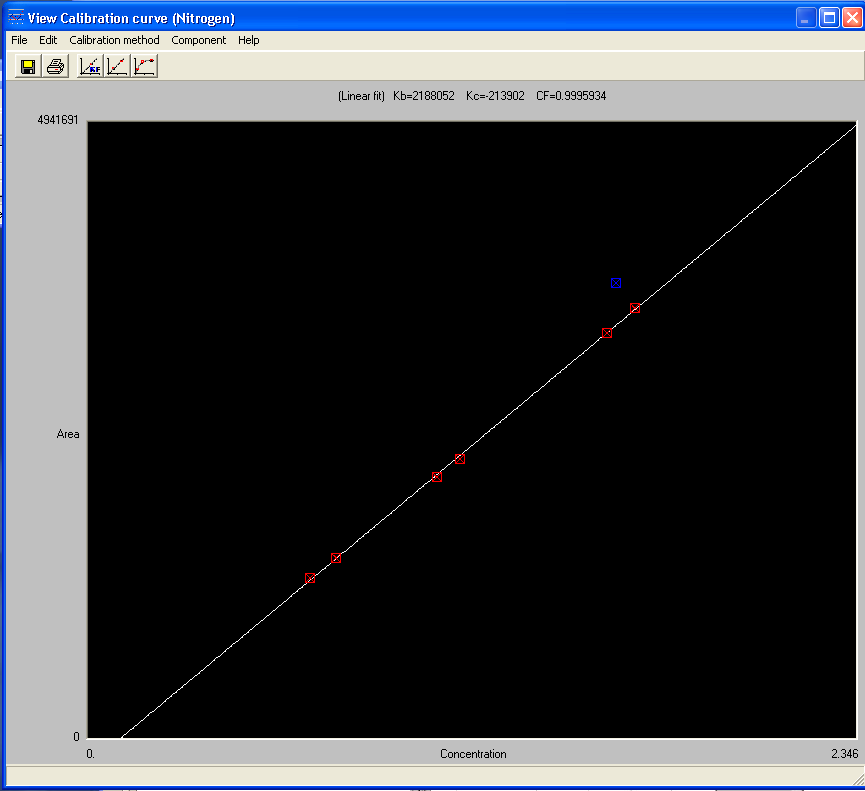
Worklist Generator
Use the Worklist Generator application to identify the samples, weighed on the Cahn balance, to be run on the CHNS Analyzer. Go through the samples very carefully. Look for missing container numbers, duplicate container numbers, duplicate entries and anything out of ordinary. Get everything perfect and ready to run. Go through the container numbers several times and make sure every container number is there and that there are no duplicates. Sometimes the software saves a weighing twice. Only select one of those.
- Select only the samples you wish to export to the CHNS
- Export to the current expedition's folder.
Note: Samples will be placed in the sample table according to the container number entered when weighing (and listed in worklist generator). Container #10 will be placed on line 10 in the sample table. To adjust what line a sample is imported to, you can either edit the container number in worklist generator (for single samples) or use sample offset (will affect all exported samples). Be careful with the offset, a positive number subtracts from the container number while a negative adds to the container number. Container #10 with sample offset of -6 will import to line 16 in the sample table.
Running Samples
Upload the LIMS sample table to the instrument:
Edit > Sample Table
Edit Sample > Import sample table from LIMS (select the file exported from Worklist Generator)
When asked about clearing the sample table, click No.
- Unless starting a new column or sequence, but recommend that sample table clearing is done when needed by edit sample > clear sample table
To then save the sample table, click OK.
If a mistake is made when importing, or the sample table is accidently cleared, click cancel, and then no. This will not save the sample table and return it to what it before.
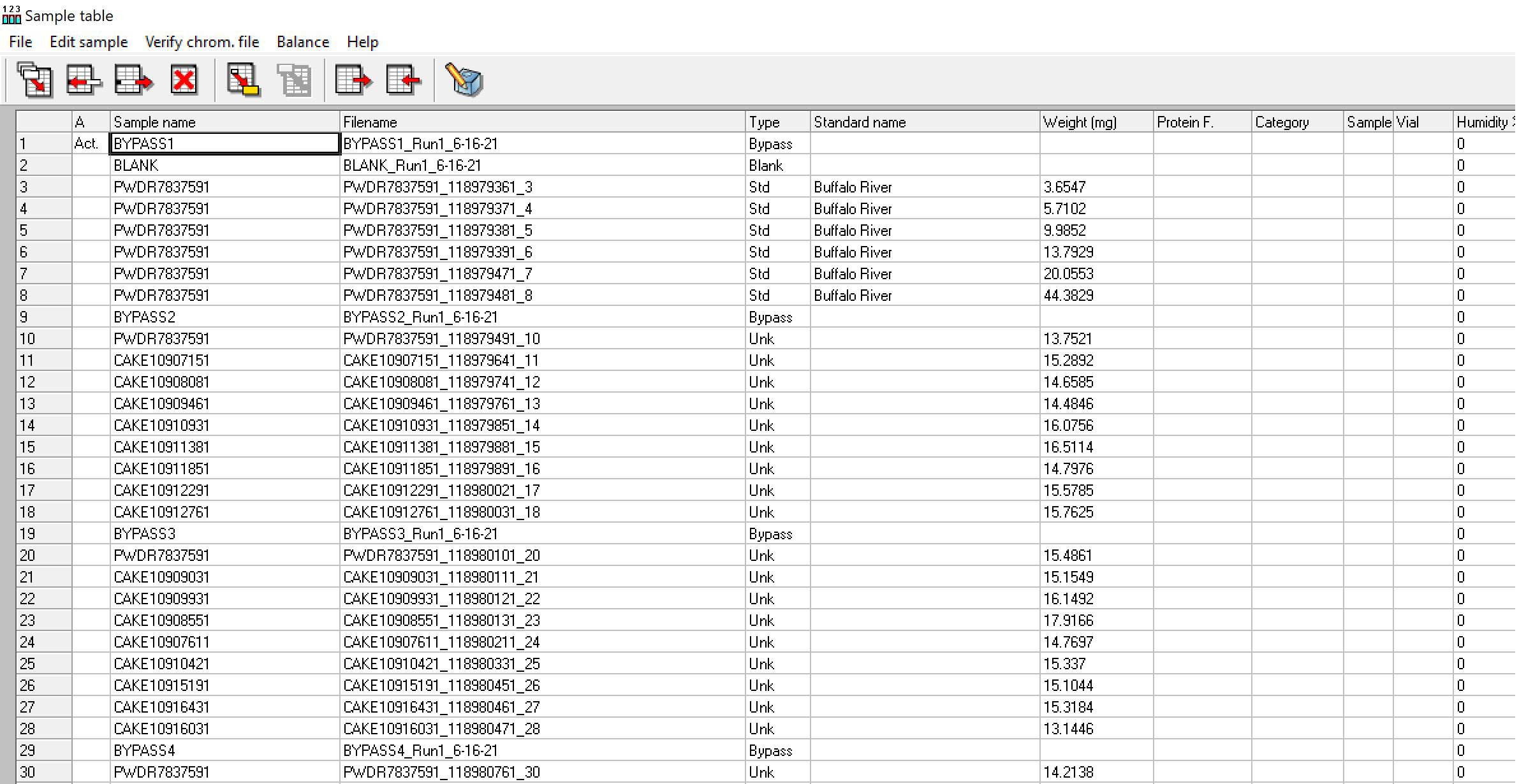
The sample/sequence table should look similar to the one above.
- Column A: Act signifies which is the current sample
- Sample name:
- BYPASS
- BLANK
- TEXT ID
- Filename: A unique name. Worklist Generator creates the names for the samples
- Type:
- Bypass (empty slot in autosampler)
- Blank (empty tin capsule)
- Std (calibration standard)
- Unk (sample or standard)
- Standard name: only the calibration standards will have this field filled in.
- Weight: Values from Worklist Generator are automatically filled in for standards and samples.
2. With the zero slot in the drop position, load the autosampler tray with the standards and samples; leave empty slots for BYPASSes. Make sure that the lid is on the tray. Advance the zero slot to slot 1.
3. Run samples:
a. Click the green icon.
b. Monitor acquisition status at View > View Sample Being Acquired. Keep an eye on the autosampler and add samples as necessary. A good time window to add samples is after the peaks have come out in a chromatogram and before the end of the run. Remember to put the lid back on after adding samples. Any samples analyzed while the lid is not on will have to be reweighed and rerun.
Analyzing Data
QA/QC data is captured by LIMS, but the technician should monitor QC values from the calibration verification (CV) standards and determine if corrective action should be taken.
After analyzing the standard and checking the instrument precision, complete the following steps.
- Go to Recalculation > Summarize results. Select weight percent results.
- Go to File > Export to Excel. Save as "site-date-filename-wtpct".
- Make a working copy of the wtpct file. Look for any negative nitrogen values and make them BDL (below detection limit). Also, if you have sulfur values show up when you didn't analyze for sulfur, make those 0. Go through all the data very carefully and tidy it up before uploading. Editing afterward will be very difficult.
- Copy the file created in Step 3 to the MUT upload directory ("Data in" folder on desktop). Save the raw data file - all files will go on Data1.

5. In MUT, select Upload to open a window as shown above in Figure 4. Uncheck all files that you are not uploading. Do not leave any bypasses or blanks checked. Check standards do get uploaded.
Click on :
a. Select Method: Choose your EA method file.
b. Select Summary: Choose the summary file from the sequence just run.
c. Select Configuration: Choose your method configuration file
d. The OK button will then become active. Click on it. The rows will turn green as they upload.
Maintenance and Troubleshooting
Installing the Reactor in the Furnaces
Warning: The reactor must be installed with the furnaces at room temperature or <50°C with gloves. Do NOT use any mechanical tools to screw or unscrew the fixing nut.
Autosampler Removal
See the FlashEA 1112 Operating Manual, p. 126–129 and 134. Pages 306–308 are also useful when replacing the O-ring of the coupling unions.
- Loosen fixing nut and remove autosampler (Figure 16, above).
- Delicately remove the used reactor (Figure 17, below, 2) from the right furnace.
- Detach O-ring from the used reactor. If O-ring is undamaged, you can use it again.
- Gently cleanup coupling union (Figure 17, 1) and O-ring. Wipe metal with alcohol if needed, but do NOT apply alcohol to O-ring. If using alcohol, apply a small amount of Vaseline to the O-ring to fix the cleaned coupling union.
- Put a kimwipe or aluminium foil on the coupling union (Figure 17, 3) to protect cleaned coupling union from dust.
- Delicately introduce the reactor into the furnace, ensuring that the tube conical end is turned downward toward the base (Figure 17, 4).
- Gently press the edge of the reactor until introduction is complete.
- Slip on the O-ring with its conical section turned upward.
- Manually screw the fixing nut.
Furnace Reactor
Cleaning the Autosampler
The autosampler does not normally require maintenance except for the sample tray. However, when the instrument is extensively used, it is a good practice to occasionally check the shaft housed in the autosampler.
Cleaning the Sample Tray
Review the FlashEA 1112 Operating Manual, p. 309–313. Once per week or whenever the autosampler is dirty, clean the sample tray as follows:
- Detach the sample tray from the autosampler.
- Using a Kimwipe and ethanol, wipe the holders and protective cover of tray.
- Place the holder with protective cover over the autosampler.
Cleaning the Shaft of the MAS 200 R Autosampler
If you detect a gas leak in the autosampler (see "Test for Leaks"), clean the shaft of the MAS 200 R. The cleaning method is shown in the FlashEA 1112 Operating Manual, p. 314–318.
Note: If you replace a shaft, you must send the old shaft back to vendor, CE Elantech, Inc., to maintain a shaft.
Connecting the Water Trap (Adsorption Filter)
Warning: Wear gloves and face protector when preparing the adsorption filter. Work with quartz wool under the draft chamber because quartz wool is an inhalation hazard.
- Introduce into either of the tube ends a sufficient amount of quartz wool to form a layer ~1 cm (1/3 in.) thick.
- Plug the tube mouth with your hand and press the quartz wool gently using a cleaned stainless steel spatula.
- Screw the nut completely with its seal onto the thread mouth.
- Pour the filling material (magnesium perchlorate) into the adsorption filter.
- At the top, add a 1 cm (1/3 in.) layer of quartz wool.
- Screw the second nut completely with its seal.
Packing a Reactor Column
If pre-filled reactor columns are not available, follow the instructions in the Flash EA 1112 vendor manual to prepare them. Packing columns is in Chapter 5 of the vendor manual; installing reactor and adsorption columns is discussed in Chapter 6. Note that the JRSO uses CE Elantech 061110 columns for sulfur, loaded with copper and tungsten oxide, but many other options are possible.
A general schematic is shown below in Figure 3. Prepare the EA reactor, adsorption filter, and chromatographic column for the desired analytical elements according to the following schematic: 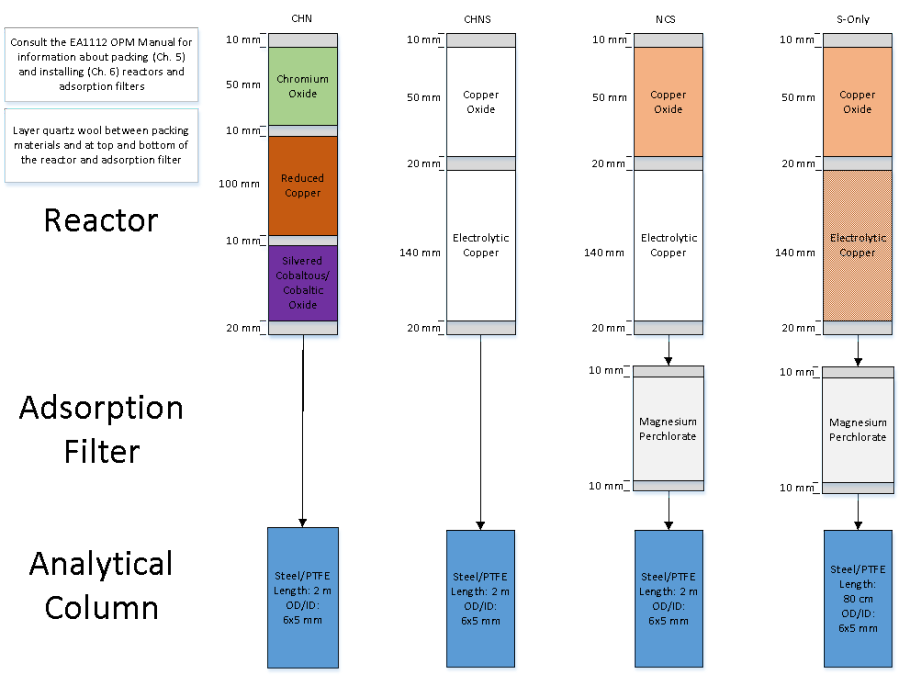
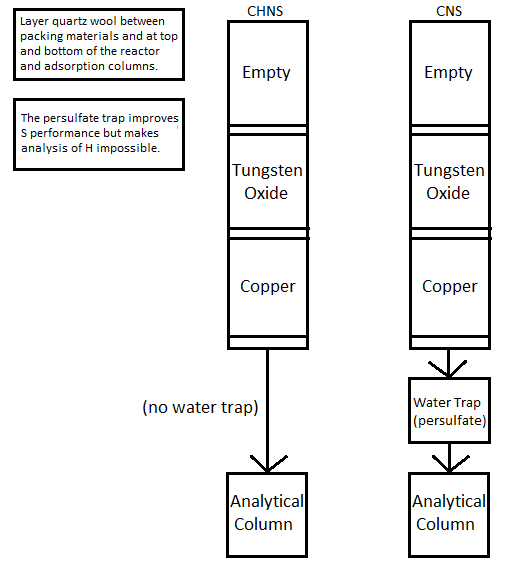
Figure 3: Analytical equipment setup based on desired elements.
Properties of reactor materials and adsorption filter: Copper oxide/chromium oxide: Creates an oxidizing environment during combustion of the sample. Vanadium pentoxide: Catalyzes the combustion of S (as sediment ion sulfate/sulfides) to sulfur dioxide. Tungsten oxide (WO3): Helps complete the oxidation of combustion products to final products.
Electrolytic copper: Reduces potentially formed nitrogen oxides and sulfur trioxide combustion products to elemental nitrogen and sulfur dioxide. Silvered cobaltous/cobaltic oxide: Catalyst used to remove sulfur dioxide and halogens. Magnesium perchlorate (anhydrone): Desiccant which removes water (i.e., combusted H) in the adsorption filter.
Quality Assurance/Quality Control
A program of quality assurance/quality control (QA/QC) ensures that a measurement system is performing within control limits and therefore provides high-quality data. The QA/QC program for this system includes instrument calibration and calibration verification, blank verification, and accuracy and precision monitoring.
Instrument Calibration
The CHNS instrument is calibrated by the chemistry technician at the beginning of the expedition. Calibration is verified routinely during operation by running calibration verification standards (see Calibration Verification).
Sequence
An analytical sequence is a group of sample runs sharing a calibration curve, blanks, reference materials, and verification samples. One sequence (table) allows a maximum of 200 samples.
Analytical Batch
An analytical batch is a group of samples run together. Each CHNS batch of unknown samples contains a calibration verification sample, calibration blank, and known sample.
Calibration Blank
A calibration blank run each sequence consists of a tin cup containing only reagent V2O5 catalyst to assess the effect that the tin cup and catalyst have on the analysis results. If the blank chromatogram has unexpected peaks or a disturbed baseline, the cause of this problem must be determined before unknown samples can be run. Notify the chemistry technician.
Calibration Verification
The calibration verification standard, also called the QC check standard, is run with each analytical batch and contains 0.6–0.7 g of BBOT in a tin cup with V2O5~ catalyst. If the calibration factor is within control limits, unknown samples can be run. If the calibration factor is outside of control limits, edit the component table and integration parameters and recalculate the calibration factor.
Poor calibration verification results can also indicate degradation of the reactor. If calibration cannot be verified, notify the onboard laboratory specialist.
Precision
Precision is the degree to which further measurements will show the same or similar results. To analyze for precision on this system, a standard (sulfanilamide, BBOT, or aspartic acid) is run in duplicate or triplicate and the standard deviation of the results calculated for each element:
where = average of results, and N = number of data points.
Accuracy
Accuracy is the degree of closeness of a measured value to the actual (true) value. A standard of sulfanilamide in a tin cup with V2O5 catalyst is run with each sequence to verify accuracy. Results of the standard must be within ±10% of true values for the system to be considered in control. Sulfanilamide true values and control limits:
- C = 41.848% (37.663%–46.033%)
- H = 4.685% (4.217%–5.154%)
- N = 16.267% (14.640%–17.894%)
- S = 18.620% (16.758%–20.482%)
- O = 18.582% (16.724%–20.440%)
- Other materials (e.g., USGS reference sediments) can be used to measure accuracy, so long as their values are known.
LIMS Integration
Sample/Analysis Components
Analysis | Component name | Unit | Description |
CHNS | carbon_percent | wt% | Carbon concentration in sample |
container_number | — | Number assigned to weighed sample | |
dat_asman_id | — | ASMAN serial number for data file | |
dat_filename | — | Filename of data file | |
hydrogen_percent | wt% | Hydrogen concentration in sample | |
mass | mg | Mass of sample | |
nitrogen_percent | wt% | Nitrogen concentration in sample | |
run_test | — | Test number of related calibration | |
sulfur_percent | wt% | Sulfur concentration in sample |
When uploading data enter the term "Rejected" in place of the value for an elemental concentration for a sample or series of samples that followed a running standard in which the analytical error exceeded the QA/QC limits (10% for each element). This displays "Rejected" in LIMS/LORE for only that specific sample element and still keeps intact the excel file containing the raw data which is uploaded to the database.
Health, Safety, & Environment
Safety
General
- Before using the gases, chemicals, and filling materials required for this procedure, carefully read the MSDS for that material.
- Proper personal protective equipment must be used for handling all apparatus and materials in this procedure.
- Gas cylinders are pressure hazards and should be changed only by shipboard staff. High-pressure gas lines can be hazardous if there are leaks, particularly the oxygen line.
- The instrument has a safety cutoff feature that cuts power to the furnace heating elements if the instrument malfunctions due to a component failure or abnormal operating conditions. If the red safety LED indicator on the synoptic panel is illuminated, contact laboratory staff immediately.
Warnings
- WARNING! Do not open the furnace compartment during operation.
- WARNING: Do not touch either furnace when the furnace temperature is higher than 40°C. Furnace temperature is shown in the EA 1112 Status screen (Select View > View Elemental Analyzer Status).
- WARNING: Do not open the protection panel. The gas chromatographic column may only be serviced by the shipboard technicians.
Compressed Gases
- Gas cylinders are pressure hazards and should be changed only by shipboard staff. High-pressure gas lines can be hazardous if there are leaks, particularly the oxygen line.
- United States standards for inert gas and oxidation regulators exist to physically prevent the user from hooking an oxidizing gas (e.g., O2) to an inert gas line and vice versa. Always use the appropriate CGA fitting for each gas! The JRSO uses the following fitting types for the gases used in this method:
- Inert Gas (Helium): CGA 580 (male, right-hand threading)
- Oxidizing Gas (Oxygen): CGA 540 (female, right-hand threading)
- Adapters do exist to convert one gas fitting to another: do not use them! The gender and threading direction of the standard fittings are designed to protect the user.
- Gas cylinders should always be restrained at two points by a strap or chain. In the case of single cylinders at use in the laboratory, do not share a strap or chain between two cylinders: each cylinder should have its own restraining gear. In the case of the gas racks in the hold, consult with the Laboratory Officer before attempting to separate a gas cylinder from the rack.
- Specific Gas Descriptions
- Oxygen is an odorless colorless gas that is a strong oxidizer. An oxygen leak could cause spontaneous combustion if an organic source is at hand. Always check the O2 lines for leaks. Appropriate precautions should be taken.
- Helium is an odorless colorless inert gas. Rapid release of He from a cylinder could potentially asphyxiate the user, so appropriate precautions should be taken.
Chemical Safety
Many of the chemicals used in the CHNS procedure, including the standards, present potential chemical hazards. Always read the material safety data sheet (MSDS) of each and every chemical before working with them. Some of the highest-hazard chemicals are summarized below:
Magnesium Perchlorate
Extremely Strong Oxidizer! Keep away from organic materials and mineral acids.
Air and Water Reactive!
- Highly exothermic upon addition of water
- Absorbs water from air
- May explode under prolonged exposure to heat
- Will increase intensity of a fire
Health hazard:
- Inhalation: irritant
- Contact: irritant
- Ingestion: abdominal pain, vomiting, diarrhea, may be fatal
Vanadium Pentoxide
Extremely toxic! Always use the appropriate personal protective equipment (PPE) and environmental controls when using this chemical.
Harmful if swallowed or inhaled
Causes serious eye damage
May cause respiratory irritation
Suspected of causing genetic defects, damaging fertility, and/or harm of the unborn child
Causes damage to internal organs through prolonged or repeated exposure
Toxic to aquatic life with long-lasting effects
Pollution Prevention
Degree of pollution according to IEC 664 = 2
Waste Management
This procedure generates no waste for disposal beyond the standard chemistry laboratory protocols.
LIMS Component Table
The following tables contain all of the LIMS components for the entire CHNS process.
| ANALYSIS | TABLE | NAME | ABOUT TEXT |
| CHNS | SAMPLE | Exp | Exp: expedition number |
| CHNS | SAMPLE | Site | Site: site number |
| CHNS | SAMPLE | Hole | Hole: hole number |
| CHNS | SAMPLE | Core | Core: core number |
| CHNS | SAMPLE | Type | Type: type indicates the coring tool used to recover the core (typical types are F, H, R, X). |
| CHNS | SAMPLE | Sect | Sect: section number |
| CHNS | SAMPLE | A/W | A/W: archive (A) or working (W) section half. |
| CHNS | SAMPLE | text_id | Text_ID: automatically generated database identifier for a sample, also carried on the printed labels. This identifier is guaranteed to be unique across all samples. |
| CHNS | SAMPLE | sample_number | Sample Number: automatically generated database identifier for a sample. This is the primary key of the SAMPLE table. |
| CHNS | SAMPLE | label_id | Label identifier: automatically generated, human readable name for a sample that is printed on labels. This name is not guaranteed unique across all samples. |
| CHNS | SAMPLE | sample_name | Sample name: short name that may be specified for a sample. You can use an advanced filter to narrow your search by this parameter. |
| CHNS | SAMPLE | x_sample_state | Sample state: Single-character identifier always set to "W" for samples; standards can vary. |
| CHNS | SAMPLE | x_project | Project: similar in scope to the expedition number, the difference being that the project is the current cruise, whereas expedition could refer to material/results obtained on previous cruises |
| CHNS | SAMPLE | x_capt_loc | Captured location: "captured location," this field is usually null and is unnecessary because any sample captured on the JR has a sample_number ending in 1, and GCR ending in 2 |
| CHNS | SAMPLE | location | Location: location that sample was taken; this field is usually null and is unnecessary because any sample captured on the JR has a sample_number ending in 1, and GCR ending in 2 |
| CHNS | SAMPLE | x_sampling_tool | Sampling tool: sampling tool used to take the sample (e.g., syringe, spatula) |
| CHNS | SAMPLE | changed_by | Changed by: username of account used to make a change to a sample record |
| CHNS | SAMPLE | changed_on | Changed on: date/time stamp for change made to a sample record |
| CHNS | SAMPLE | sample_type | Sample type: type of sample from a predefined list (e.g., HOLE, CORE, LIQ) |
| CHNS | SAMPLE | x_offset | Offset (m): top offset of sample from top of parent sample, expressed in meters. |
| CHNS | SAMPLE | x_offset_cm | Offset (cm): top offset of sample from top of parent sample, expressed in centimeters. This is a calculated field (offset, converted to cm) |
| CHNS | SAMPLE | x_bottom_offset_cm | Bottom offset (cm): bottom offset of sample from top of parent sample, expressed in centimeters. This is a calculated field (offset + length, converted to cm) |
| CHNS | SAMPLE | x_diameter | Diameter (cm): diameter of sample, usually applied only to CORE, SECT, SHLF, and WRND samples; however this field is null on both Exp. 390 and 393, so it is no longer populated by Sample Master |
| CHNS | SAMPLE | x_orig_len | Original length (m): field for the original length of a sample; not always (or reliably) populated |
| CHNS | SAMPLE | x_length | Length (m): field for the length of a sample [as entered upon creation] |
| CHNS | SAMPLE | x_length_cm | Length (cm): field for the length of a sample. This is a calculated field (length, converted to cm). |
| CHNS | SAMPLE | status | Status: single-character code for the current status of a sample (e.g., active, canceled) |
| CHNS | SAMPLE | old_status | Old status: single-character code for the previous status of a sample; used by the LIME program to restore a canceled sample |
| CHNS | SAMPLE | original_sample | Original sample: field tying a sample below the CORE level to its parent HOLE sample |
| CHNS | SAMPLE | parent_sample | Parent sample: the sample from which this sample was taken (e.g., for PWDR samples, this might be a SHLF or possibly another PWDR) |
| CHNS | SAMPLE | standard | Standard: T/F field to differentiate between samples (standard=F) and QAQC standards (standard=T) |
| CHNS | SAMPLE | login_by | Login by: username of account used to create the sample (can be the LIMS itself [e.g., SHLFs created when a SECT is created]) |
| CHNS | SAMPLE | login_date | Login date: creation date of the sample |
| CHNS | SAMPLE | legacy | Legacy flag: T/F indicator for when a sample is from a previous expedition and is locked/uneditable on this expedition |
| CHNS | TEST | test changed_on | TEST changed on: date/time stamp for a change to a test record. |
| CHNS | TEST | test status | TEST status: single-character code for the current status of a test (e.g., active, in process, canceled) |
| CHNS | TEST | test old_status | TEST old status: single-character code for the previous status of a test; used by the LIME program to restore a canceled test |
| CHNS | TEST | test test_number | TEST test number: automatically generated database identifier for a test record. This is the primary key of the TEST table. |
| CHNS | TEST | test date_received | TEST date received: date/time stamp for the creation of the test record. |
| CHNS | TEST | test instrument | TEST instrument [instrument group]: field that describes the instrument group (most often this applies to loggers with multiple sensors); often obscure (e.g., user_input) |
| CHNS | TEST | test analysis | TEST analysis: analysis code associated with this test (foreign key to the ANALYSIS table) |
| CHNS | TEST | test x_project | TEST project: similar in scope to the expedition number, the difference being that the project is the current cruise, whereas expedition could refer to material/results obtained on previous cruises |
| CHNS | TEST | test sample_number | TEST sample number: the sample_number of the sample to which this test record is attached; a foreign key to the SAMPLE table |
| CHNS | CALCULATED | Top depth CSF-A (m) | Top depth CSF-A (m): position of observation expressed relative to the top of the hole. |
| CHNS | CALCULATED | Bottom depth CSF-A (m) | Bottom depth CSF-A (m): position of observation expressed relative to the top of the hole. |
| CHNS | CALCULATED | Top depth CSF-B (m) | Top depth [other] (m): position of observation expressed relative to the top of the hole. The location is presented in a scale selected by the science party or the report user. |
| CHNS | CALCULATED | Bottom depth CSF-B (m) | Bottom depth [other] (m): position of observation expressed relative to the top of the hole. The location is presented in a scale selected by the science party or the report user. |
| CHNS | RESULT | batch | RESULT batch number: batch number generated by the Thermo Flash software to identify a given group of samples |
| CHNS | RESULT | carbon_organic_percent (wt%) | RESULT organic carbon (wt%): organic carbon by percent weight; on this instrument, requires a pre-run treatment to remove inorganic carbon; this is not the carbonates report organic carbon, which is the difference between CHNS total C and coulometer inorganic C |
| CHNS | RESULT | carbon_percent (wt%) | RESULT elemental carbon (wt%): total carbon by combustion expressed in percent weight |
| CHNS | RESULT | chns_mass (mg) | RESULT mass of sample (mg): mass of sample weighed out for a CHNS run |
| CHNS | RESULT | config_asman_id | RESULT configuration file ASMAN_ID: serial number of ASMAN record containing the CHNS instrument configuration file |
| CHNS | RESULT | config_filename | RESULT configuration file filename: file name of the CHNS instrument configuration file |
| CHNS | RESULT | container_number | RESULT container_number: the container number for the sample being analyzed; in this context, it's a position on the tray and in the CHNS autosampler |
| CHNS | RESULT | datafile_asman_id | RESULT data file ASMAN_ID: serial number of ASMAN record containing the CHNS instrument data file (binary format) |
| CHNS | RESULT | datafile_filename | RESULT data file filename: file name of CHNS instrument data file (binary format) |
| CHNS | RESULT | hydrogen_percent (wt%) | RESULT elemental hydrogen (wt%): total hydrogen by combustion expressed in percent weight |
| CHNS | RESULT | mass (mg) | RESULT mass of sample (mg): mass of sample weighed out for a CHNS run; duplicate component that is often populated with the chns_mass, but not always |
| CHNS | RESULT | method_asman_id | RESULT method file ASMAN ID: serial number of ASMAN record containing the CHNS method file |
| CHNS | RESULT | method_filename | RESULT method filename: file name of the CHNS method file |
| CHNS | RESULT | nitrogen_percent (wt%) | RESULT elemental nitrogen (wt%): total nitrogen by combustion expressed in percent weight |
| CHNS | RESULT | ssup_asman_id | RESULT spreadsheet uploader ASMAN_ID: serial number of ASMAN record for the spreadsheet uploader file |
| CHNS | RESULT | ssup_filename | RESULT spreadsheet uploader filename: file name of spreadsheet uploader file |
| CHNS | RESULT | sulfur_conc (ppm) | RESULT elemental sulfur (ppm): total sulfur by combustion expressed in parts per million (w/w) |
| CHNS | RESULT | sulfur_percent (wt%) | RESULT elemental sulfur (wt%): total sulfur by combustion expressed in weight percent |
| CHNS | RESULT | summary_asman_id | RESULT summary file ASMAN_ID: serial number of ASMAN record for the CHNS summary file |
| CHNS | RESULT | summary_filename | RESULT summary filename: file name of CHNS summary file |
| CHNS | RESULT | treatment_method | RESULT treatment method: indicator for treatment method (e.g., silver cups with acid treatment to remove carbonate) |
| CHNS | SAMPLE | sample description | SAMPLE comment: contents of the SAMPLE.description field, usually shown on reports as "Sample comments" |
| CHNS | TEST | test test_comment | TEST comment: contents of the TEST.comment field, usually shown on reports as "Test comments" |
| CHNS | RESULT | result comments | RESULT comment: contents of a result parameter with name = "comment," usually shown on reports as "Result comments" |
Archive Versions
CHNS User Guide: 29th September 2022
